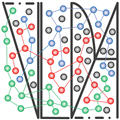The Voluntary Law Development Association is dedicated to building, maintaining, and promoting a detailed system of alternative laws designed for voluntary adoption by individuals, using community-based development models similar to those used for open-source software. Rather than imposing laws by political fiat or concentrating capital, VLDA aims to distribute law-making power to the very atom of society: the individual. By concurring in the selection of preferred laws, individuals coalesce into communities, here called “voluntary law societies” (VLSs). This radical grass-roots approach to law entails numerous complexities and issues that VLDA aims to bring to light and develop solutions for, as part of laying groundwork for a more equitable, free, and peaceful future society.
This website aspires to be one of the portals for accessing and interacting with a developing body of open-source voluntary laws. As development progresses, you will find growing here links to VLDA’s Hierarchy of Voluntary Laws (sometime called the Higher Archy or “HA” for short). The Higher Archy is a hierarchically organized table of modular legal codes organized by systems, categories, and any number of levels of subcategories or subsystems. To qualify for inclusion in the HA, each code module must be designed for the peaceful resolution of disputes between persons, must adhere to the principle of equality under the law, and must assume that any entity applying the law to render a judgment or any entity enforcing such judgment does not claim any exclusive right of action beyond what is personally and voluntarily granted by the disputants.
A system or subsystem is any internally consistent set of code modules, meaning that all of the modules in the set are operable without logical contradiction. Otherwise contradictory modules or sets of modules (i.e., systems) can be made consistent with one another by operation of a conflict of laws module. Conflict of laws modules can be used to join otherwise contradictory systems of laws, essentially making each of the reconciled systems into subsystems of a larger system. Modules of a system do not need to be identified as belonging to a particular system or subsystem, but such information is generally helpful and should be provided if appropriate.
Categories or subcategories can be any useful subdivision of a system of laws. They should be designed to enhance readability and usability of a system of laws by breaking it down into smaller, logically related chucks. VLDA does not presently enforce any particular categorization scheme or schemes for law systems, but reserves the right to do so at its administrator’s own discretion.
Also found here will be the Commentary on the HA, which should provide examples and explanations for how specific modules in the HA might work in practice. It is a good place for critics to pose hypotheticals demonstrating weaknesses of particular laws, and offer suggestions for improvements.
The administrator hopes there will eventually be many illustrious contributors to the HA and the Commentary. Currently, the administrator is solely responsible for approving submissions for publication, but only because the volume of contributions is light or non-existent. All contributions are published under the Creative Commons 3.0 Attribution license.
Thank you for your interest in the VLDA and have a nice day!
